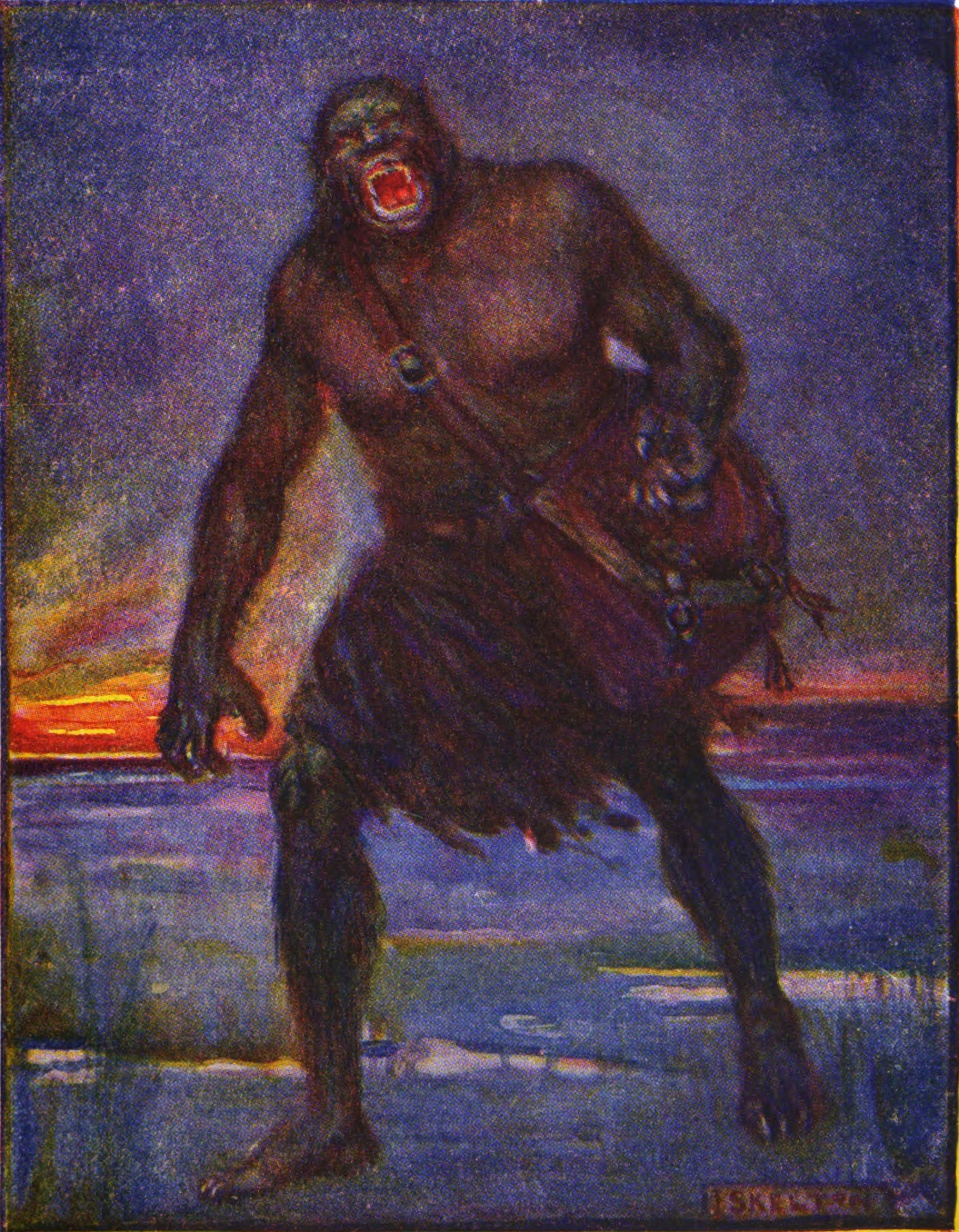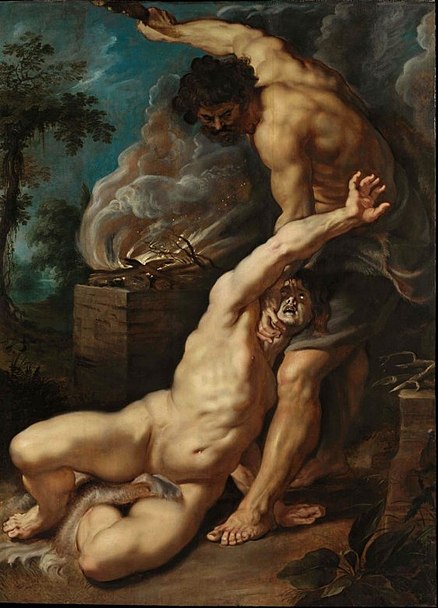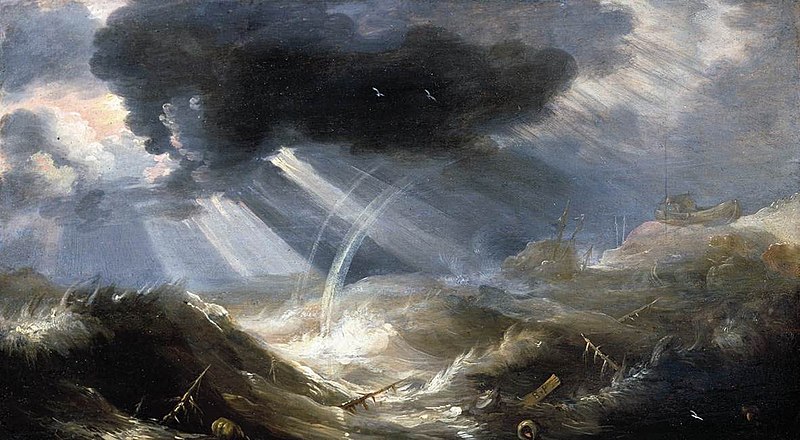
Grendel was the name of this grim demon haunting the marches, marauding round the heath and the desolate fens; he had dwelt for a time in misery among the banished monsters, Cain's clan, whom the Creator had outlawed and condemned as outcasts (Beowulf, trans Seamus Heaney)
I'm finally going to talk about Grendel, who is probably more interesting to most people than Grendel's Mother (except when she's Angelina Jolie, of course). There's lots of different views on Grendel, mostly whether he's human or beast or human-beast or a bipedal dragon (seriously). I haven't quite made my mind up about Grendel - I do know I am sympathetic to his character, but I'm not certain how human he is. I don't think I can be quite so certain about Grendel as I am with Grendel's Mother, but I'm sure within the next year of studying my arse off I will have a better idea!
So...what we know about Grendel from his first introduction is that he is of Cain's clan, or at least lives with the feckers. From Cain also sprang the orcs and the elves and the giants (or as translated by Edwin Morgan (presumably while on an intense high), "kobolds and gogmagogs, lemurs and zombies"....eh, sure). So, for the purposes of this post, we'll say he is of Cain's descent, because let's face it, I wouldn't be writing this otherwise.

We all know Cain - he's the feen who killed Abel, his brother, for some reason or another, and thus became the first murderer and the first to fall under a curse. As a punishment, he was exiled and so were all who descended from him, and bore the "mark of Cain" (not necessarily a physical mark).
So, as one theory goes, the sons of God (conflicted ideas of whether these are men of Seth or the "Watchers") mated with the daughters of men (Cain) and produced the Nephilim, a race of giants who inhabit the earth in Genesis. However, there are conflicting ideas about this theory - it never says directly that the Nephilim were the offspring of the sons of God and daughters of men. Grendel being a giant, and being a descendent of Cain, means he is possibly connected to the Nephilim, but, the only problem here is that these giants were washed away in the Great Flood of Cork in 2014...or whatever time frame it was that Noah was around.
HOWEVER, fear not ( I know you were), another door lies somewhat ajar here. There are some roads leading from the statement in Genesis about the earth having to open her mouth and receive Abel's blood, quite the cannibalistic image. This is also repeated in the Old English Geneis A; "Feud occurred for the kin of men, since the earth first swallowed Abel's blood". In the Book of Enoch (aka I Enoch), a book which, judging what the good old Bede says, was somewhat popular with the Anglo-Saxons, it is said that the race of giants born from the daughters of men "devoured one another's flesh and drank the blood from it". It is possible that Beowulf was written in a time in Anglo-Saxon England when everyone from Ælfric to Bede and Wulfstan were freeaaking out about blood and laying down prohibitions about drinking it (this was mostly to do with animals in case you are wondering), along with major issues such as eating while taking a dump. Bede himself said that consuming blood was the greatest sin of the giants. And, finally getting to the point...Grendel also consumes blood - so in this way, he is linked to the Genesis giants and Cain.

The Great Flood, by Bonaventura Peeters
Yes, but still, the Great Flood. Well, apparently, Ham (or Cham), son of Noah, was the first person to be cursed after the Flood, as he inscribed secrets into stone and metal to preserve them from the Flood: "When the Flood was over he sought them out with the same curiosity for sacrilegious things with which he had hidden them, and transmitted the seeds of perpetual wickedness to later generations" (Book of Cassian). Similar episodes can also be seen in a number of Irish works, including the Middle Irish Sex aetates mundi, which states that Cham is the "heir of Cain after the Flood, and from him sprang leprechauns, and giants, and horseheads, and in general every unshapely form that men have", which is extremely, in a too-good-to-be-true way, really similar to the line in Beowulf about "ogres and elves and evil shades - as also the giants" (Alexander's trans). I really love that leprechauns and horseheads bit though. Kind of makes me wonder why I didn't study ancient Irish texts...too feckin' late now though.

The Fall of the Rebel Angels by Pieter Bruegel the Elder
According to Andy Orchard (who I owe much thanks to in this post: Thanks, man), there is another possible link in the sword that is found in Grendel's mere, the one Beowulf uses to finally kill Grendels Mother. In the Book of Enoch we are told about "The Watchers" or "Grigori", the fallen angels who are credited with teaching metalwork and weapon-making to men: "And Azâzêl taught men to make swords, and knives, and shields, and breastplates, and made known to them the metals of the earth and the art of working them . . . And there arose much godlessness, and they committed fornication, and they were led astray, and became corrupt in all their ways." (I Enoch, Chapter 8). Such an inscription on a metal sword depicting the Flood and the giants may also be linked to Cham's inscription on the metals and stone of the earth. Although, a bit of a weaker link, but I am clutching at straws here!
So, with texts like the Book of Enoch floating about (a latin translation from Britain dating from around the possible time of Beowulf) and these numerous Irish texts with similar features, it's not impossible that Beowulf, and in particular the story of Grendel was influenced by them. Either way, it makes for some interesting reading (in my warped mind at least)

Love this post! =)
ReplyDeleteEspecially the bit about the Nephilim, Cain and the Grigori! You should read The Mortal Instruments series and The Shadowhunter Codex by Cassandra Clare. She uses this mythology for her books. ;-)
xoxo